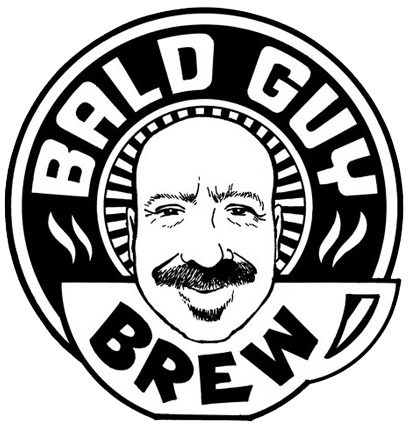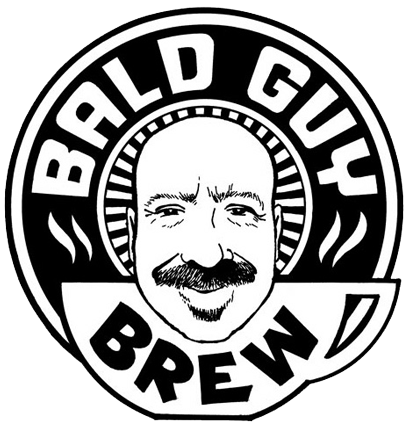Demystifying Coffee: Your Resource Guide to Making Great Coffee at Home
Posted on October 17 2025,

At Bald Guy Brew, we love not only roasting and brewing coffee. We love teaching it.
Over the years, we’ve built a library of brew guides, storage tips, roast notes, and tasting tutorials. Coffee education is the heart of what we do.
Think of this post as a quick guide at your fingertips. Each step links to a deeper dive, so you can learn the why behind the how.
Making great coffee is not magic. It’s simple science and a little attention. When you understand a few key variables and pay attention to what’s in your cup, you can brew a coffee that tastes good every morning.
So let’s demystify the process and walk the journey from the bean to the brew.
1. It Starts with the Bean
Every great cup begins with great coffee. The bean’s origin, altitude, and processing all shape its sweetness, acidity, and body. The roast brings those qualities to life.
Roast level matters.
Light roasts highlight bright, floral notes and crisp acidity. Medium roasts balance sweetness and body. Dark roasts emphasize chocolate and caramel tones.
Freshness matters even more.
Coffee peaks within about two weeks of roasting. After that, oxygen, light, and moisture begin to dull the flavor.
If you’re curious how roast levels affect flavor, check out our Guide to Coffee Roasts.
To keep your beans tasting their best, read Tips and Tricks to Keep Coffee Fresh at Home.
2. Grind for Your Method
Once you have good coffee beans, grinding them right makes all the difference. Grind size controls how quickly water moves through the coffee and how much flavor gets extracted.
Quick reference:
-
Coarse grind: French press or cold brew
-
Medium grind: Drip or pour-over
-
Fine grind: Espresso
Think of grind as the gatekeeper of flavor. Too fine, and your cup tastes bitter. Too coarse, and it tastes flat. Pair the right grind with your brew method for balance and consistency.
We talk more about matching grind and brew in Make Great Coffee at Home.
3. Water Quality: The Unsung Hero
Since about 98% of your coffee is water, the water you use matters just as much as the coffee itself.
Avoid strong odors or chlorine, which can overpower delicate flavors. But don’t go too far the other way — distilled water lacks minerals and can make your coffee taste dull.
Try brewing the same coffee using tap, filtered, and bottled water. Taste them side by side. You’ll quickly notice which brings your cup to life.
If you’re ready to test how freshness, storage, and water quality all work together, revisit Tips and Tricks to Keep Coffee Fresh at Home for a few practical experiments.
4. Temperature: The Sweet Spot
Temperature is the first thing I check when someone says their coffee tastes off.
The ideal brewing range is 200°F–205°F.
-
Too cool, and you’ll under-extract the flavors.
-
Too hot, and you’ll pull out bitterness instead of balance.
If you’re using a home brewer, check the water temperature with a quick-read thermometer to make sure it stays hot through the cycle.
Curious how temperature affects the flavor profile of different roasts? You can see examples of this in Coffee Cupping 101.
5. The Strength Is in the Numbers
If you want consistent results, a small kitchen scale is the best tool you can buy.
Start with a 1:15 ratio — one gram of coffee for every fifteen grams of water.
Example: 350 ml of water ÷ 15 = 23 g of coffee.
That gives you a balanced cup that you can adjust to taste:
-
1:14 for a stronger cup.
-
1:17 for a lighter cup.
Ratios make coffee repeatable. What used to be guesswork becomes second nature.
To see how professional tasters assess balance and strength, take a look at Coffee Cupping 101. It’s a great way to understand what’s happening in your cup.
6. Let’s Brew
Brewing is where time, temperature, and grind meet.
For manual pour-overs, aim for about 3 minutes total brew time to yield 350 ml of coffee. Keep your pour steady and even, letting the coffee bloom before continuing.
If you’re using a home machine, experiment with water volume and grind size until your cup tastes balanced — not sour, not bitter, just right.
For more guidance on dialing in brew time and technique, revisit Make Great Coffee at Home.
7. Taste, Reflect, Repeat
Here’s the part most people skip: tasting intentionally!
When you slow down and pay attention to what’s in your cup, you start to pick up the subtleties: the brightness of a Kenyan, the round sweetness of a Colombian, or the syrupy body of a Sumatran.
That awareness connects you not only to your coffee, but to the people and places behind it. If that resonates, take a look at What’s in Your Cup Matters.
8. Speak the Language of Coffee
The more you explore coffee, the more you realize how much there is to learn not just in flavor, but in language. Understanding the words roasters, baristas, and tasters use can deepen your appreciation for what’s in your cup.
If you’ve ever wondered what “first crack,” “bloom,” or “Maillard reaction” really mean, we’ve got you covered. Visit our Coffee Lexicon to explore the vocabulary of coffee, from green beans to grind size, roasting cycles to brew ratios.
It’s the perfect companion to this resource guide — a place to geek out, learn the language, and connect more deeply with every cup.
Let’s Bring It All Together
Great coffee isn’t about perfection. It’s about paying attention to the beans, the process, and yourself.
When you understand the basics of bean, grind, water, temperature, ratio, and time, you’ll find that great coffee is always within reach.
We think our own organic coffees, roasted fresh daily in Boone, North Carolina, are a great place to start.
Shop all our coffees and craft your perfect cup!

